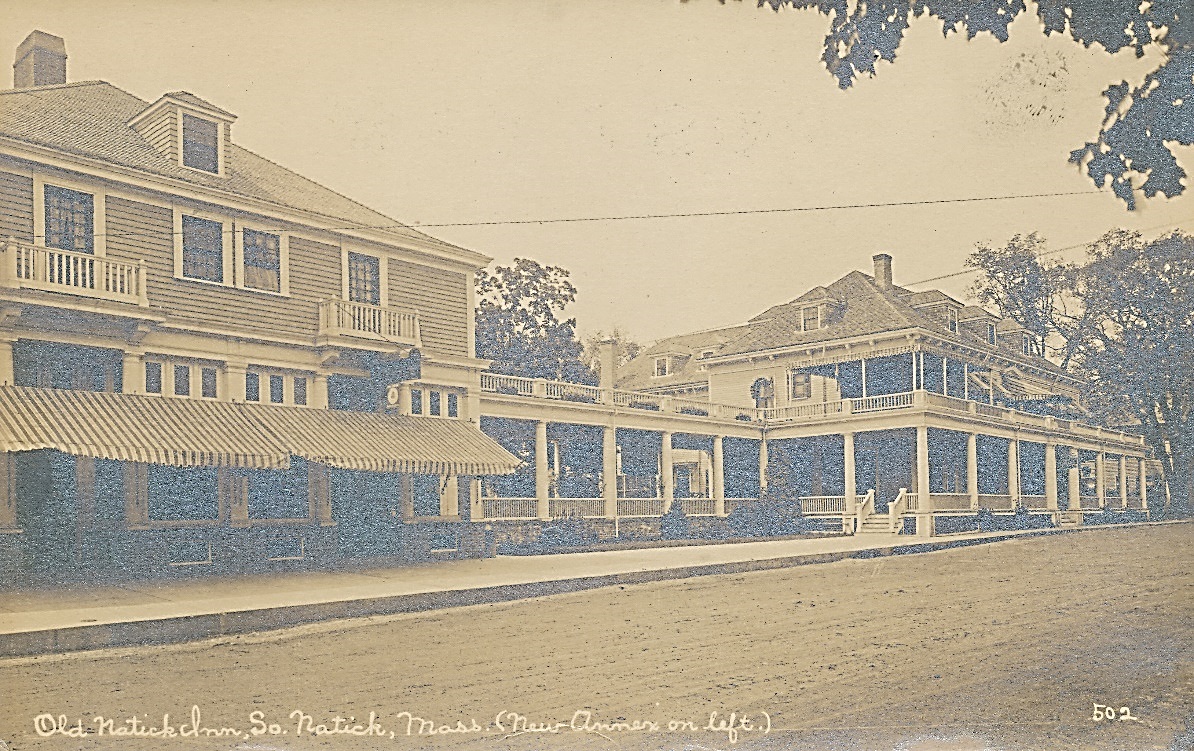
The Old Natick Inn in South Natick
Historic Inns and Taverns of Natick
The public houses of the early period in Massachusetts were located on turnpikes or through roads about one day's journey apart. They were essential to the traveler, providing food, lodging, and sometimes entertainment.
There was some town control with licenses granted by the General Court. The proprietors usually were men of prominence, holding positions in town government or of high social standing. Around 1780, general price lists were established for those taverns on the more heavily traveled roads. Whiskey, West Indies, and New England rum were sold to travelers and villagers. Meals and lodging were available, horses were boarded or hired out, and staples such as molasses, spices, cloth, and kitchen utensils were sold.
It is amusing to read some of the rules for hardy travelers who stopped for the night: "No more than five to a bed, No boots to be worn in bed, No dogs allowed upstairs, No razor grinders or tinkers taken in, Organ grinders to sleep in the wash house."
The 1748 Peletiah Morse tavern on Eliot Street in South Natick, date unknown. Source: Unknown
One of the earliest taverns in Natick was owned by Peletiah Morse. He built his home in 1748 at 33 Eliot Street, a principal route to New York. His family lived in the tavern, and rooms were available to travelers, meetings were held there, and prisoners were boarded before other facilities were available. The tavern offered a respite from the cold of the unheated Natick meetinghouse during the extended Sabbath services, and a strong drink was commonly served.
In April of 1782, Eliakim Morrill made his first purchase of two and one-quarter acres of land from the heirs of Jonathan Carver in South Natick. On this land, Morrill built the "Old Tavern," which he ran for 17 years with the help of his wife, Ruth Russell. In those early years, there were few stage coaches, no railroads, and nearly all the travel on this old road (now Route 16) between Boston and New York was on horseback or in rude wagons.
A long line of innkeepers followed Morrill’s reign at the Old Tavern. Goin Bailey became the proprietor in 1849 and kept it until he died in 1875. The original tavern stood until March 2, 1872, when it was destroyed by the fire that wiped out the South Natick business district; in 1873, Bailey erected "Bailey's Hotel" which dispensed hospitality and entertained weary and hungry travelers.
Almond Bailey, Goin Bailey's son, managed the hotel until 1908 when Mrs. Robert G. Shaw purchased it. In 1909, Mrs. Robert Shaw renovated the hotel and named it the "Old Natick Inn." It was prominently advertised as situated on the beautiful Charles River above the dam at Old Town Park. In 1915, Mrs. Shaw bought the adjacent block of stores torn down to build an annex to the Inn. By 1930, after a period of mismanagement and disuse, the Inn was torn down, and a park was made on its site. The annex was purchased by Raymond Cooper and altered to become a drug store and a hardware store. The drug store later expanded into the entire space. Current tenants on the site include a gourmet coffee shop.
In Natick Center, the Old Morse Tavern stood on what is now East Central Street. It was owned and operated by Rufus Morse. The second story was one long hall which, when completed, was dedicated with a grand ball. About 80 couples from Boston came by stage, and the magnificence of the occasion was discussed long after the event. This hall was the scene of the village's dances, parties, and lectures for many years. In 1845, the Takawambpait Lodge of Odd Fellows was instituted, and the meetings were held in the second-floor hall. The family lived in the lower part of the building. Morse kept a small store where he sold milk, West Indies goods, and New England rum, like all groceries of the period.
The “Old Natick Inn” on Eliot Street, west of the meetinghouse, and current site of Shaw Park, date unknown. Source: Unknown
After the railroad was built in 1835, the Long Pond Hotel was erected near the depot, and such trade as there was gravitated to it, leaving the old inn with few customers. After a few years, Morse turned his building into tenements. Henry Wilson's parents were among the families that made their home there. In the 1860s, the building was sawed into three parts and moved to different locations. The St. Patrick's Church Rectory now occupies where the old inn stood. The Long Pond Hotel was dedicated to a grand ball held in the third-floor ballroom. The ball was led by two prominent Natick citizens, Russell L. Bent and Mrs. Charles Underwood. A fire destroyed much of the building, and it was rebuilt as the Ahern Block.
After the Great Fire of 1874 in downtown Natick, the Wilson House was built on Summer Street to accommodate the public in first-class surroundings. It was built by John Eliot Fiske, a member of one of Natick's oldest families. Fiske was an ardent temperance advocate and dedicated the hotel to temperance at an excellent opening banquet. It was also dedicated to Henry Wilson, who greatly supported the temperance "Cause." When Fiske moved to California, the hotel policy changed. Proprietor L.E. Gleason advertised the hotel as "new with all modern improvements and steam heat." The hotel eventually housed several stores and became a boarding hotel for bachelors.
The Felch family owned a tavern still standing on the northeast corner of Bacon and North Main streets in the section of Natick historically known as Felchville. Now it is known as the Isaac Felch house.
From the stagecoach days, an inn at North Main Street and the Worcester Turnpike were kept as a hostelry. It has been known as Black's Tavern, the Haynes Tavern, Penniman's, Lake Shore House, Elm Park Hotel, and Sunnyside. In 1833, when it was called Penniman's Tavern, Henry Wilson boarded there on his arrival from New Hampshire. As the Lake Shore House, it was run by H.T. Hildreth. Hildreth built a large hall where balls were held, but when this proved unprofitable, it was turned into a carriage manufacturing enterprise. 1872, it was purchased by C. H. Sherman and was reconstructed as a hotel.
In 1873, it was advertised that the hotel "had been refitted and furnished with modern improvements for the comfort of guests, affording one of the most attractive homes for the traveling public. The Table d'Hote is furnished with all the delicacies of the season. No pains, whatever will be spared to cater to the wants of the public, and everything that pertains to a first-class hotel will be here found, and every want to be supplied, at terms that are the most reasonable and in style, the most recherché. Omnibuses pass the house on arrival and departure of trains. In connection with the House is Elm Park, one of the best half-mile tracks in the State. Horses trained by C.W. Howland."
John L. Sullivan trained at Elm Park for his fight with Joe Goss when the "Boston strong boy" debuted in 1881. David Sheehan managed both the hotel and a professional baseball team. In 1887, John Draper bought Elm Park house and the race track. Trotting meets were popular, attracting patrons to the track and the hotel. Called in later days the Sunnyside Hotel, the building was moved in the late 1920s to the south side of Worcester Street on the east side of North Main Street and used to manufacture a soft drink called Rex Beverage. It was dismantled in the 1930s to allow the Route 9 access ramps to be constructed.
So ended the era of the old taverns and hotels in Natick.
READ MORE ABOUT HISTORIC HOUSES IN NATICK
CLICK HERE
return to 19th-century menu:
click here
Selected sources and additional reading:
Natick Historical Society Collections.


